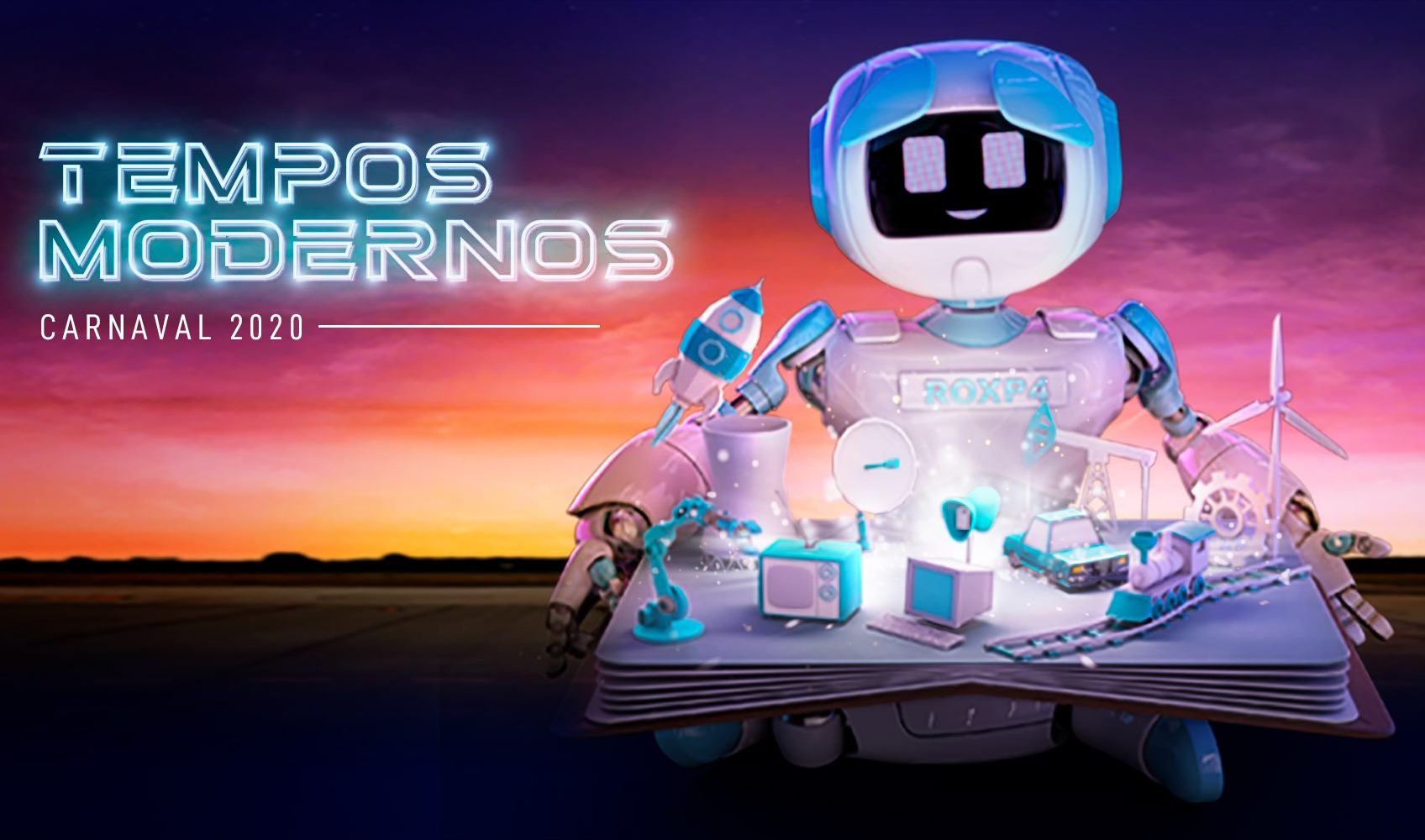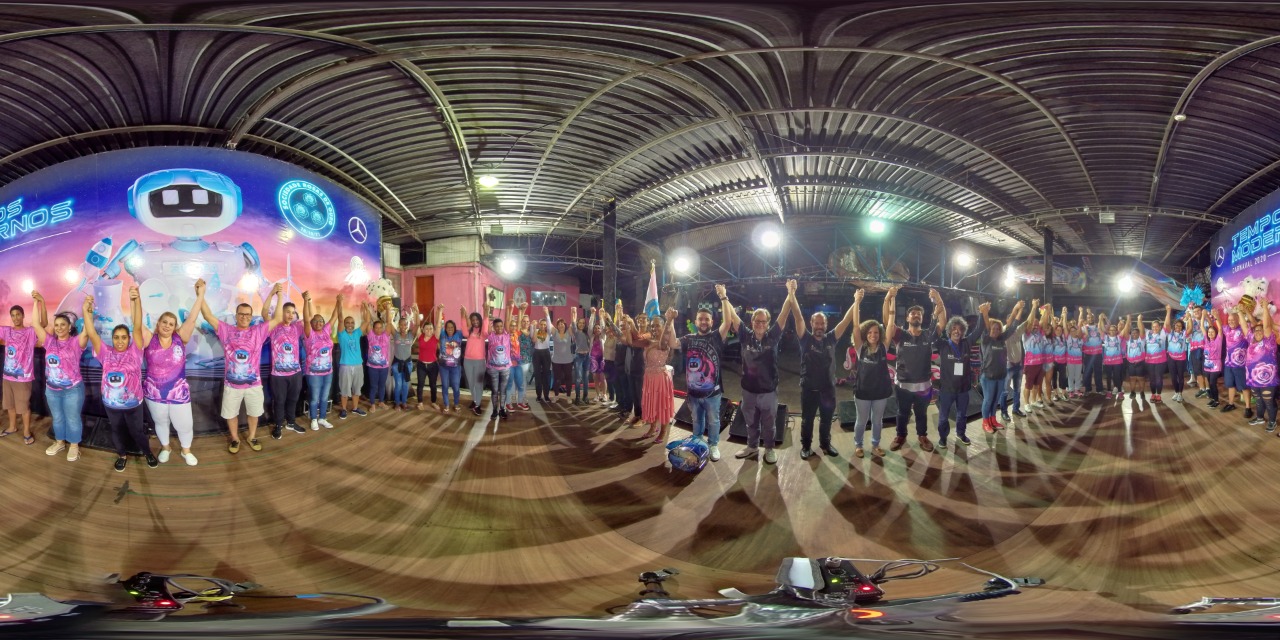LabArteMídia — the Laboratory of Art, Media and Digital Technologies, led by Prof. Dr. Almir Almas — was invited to take part in the “Carnival 4.0” project alongside The Rosas de Ouro Samba School and a network of universities: the University of São Paulo (USP), FEI University Center, MAUÁ Institute of Technology and UFABC. The partnership in Art & Technology projects aims to create experiences for the Samba School’s 2020 Carnival, with the storyline “Modern Times”.

The ROXP4 robot symbolizes the technologies that transform our lives. Image source: Disclosure.
The Samba School Parade for the São Paulo Carnival takes place on February 22 and 23, 2020 at the Anhembi Sambadrome. Its audience will be able to experience the parade through various technological devices.
LabArteMídia will present Art & Technology solutions, Digital Allegories with Augmented Reality, 360° video capture of the parade, as well as VR experiences and a making of of these actions. It has the technological support of the Superintendence of Information Technology (STI), the University of São Paulo, Jandig (Open Source community of art in augmented reality), Inclusiva (Sociodigital inclusion), and Imago (360° video solutions).
In an article on UOL, Prof. Almir Almas talks about the thinking behind LabArteMídia’s intervention in the parade:
“We’re going to unite the science of academia with popular science. This parade will be an incredible response to what we are experiencing. This time when culture and research are so forgotten and undervalued”
LabArteMídia, at CTR/ECA/USP, has the support of the USP Rectorate, the Dean of Culture and Extension, the Dean of Research, the Board of the School of Communications and Arts and the Polytechnic School.
The “Carnival 4.0” project is made up of a network of universities, companies and artists, in partnership with the Rosas de Ouro Samba School. “Modern Times” is this year’s samba tune, created by André Machado.
In an article dated February 19, 2020, Forbes Magazine describes the technologies that the network of universities is bringing to the event. The article states:
“Augmented reality is one of the resources used to surprise spectators. Virtual markers for cell phones will allow the audience to follow a dancer’s volleys. An app, available for iOS and Android, will make it possible to zoom in on the details of the five floats that will enter the avenue. In addition, people who have downloaded the app will be able, via a QR Code, to check out a sixth vehicle – projected only virtually. ROXP4 (pictured), the robot-mascot of the samba enredo, in charge of looking after a child until he becomes obsolete, will also come to life thanks to technology.
As far as the members of the school are concerned, all the wings – as well as the school’s president, Angelina Basílio, the carnavalesco and the mestre de bateria – will be monitored in real time using a smart bracelet to collect information such as heart rate, calories burned, steps and distance traveled. This data, processed in the cloud, will be compared with the revellers’ medical examinations to establish correlations between their performance on the avenue and their state of health.
To portray productivity, RFID (radio frequency) tags have been installed on the costumes, so as to track who has entered the avenue and know their destination after the parade. The devices will monitor the performance of each of the school’s 31 compositions along the 530-meter length during the 65 minutes – the maximum time allowed for each school – thanks to four signal collection stations installed along the route. The performance will be portrayed on a dashboard by means of colors – green, yellow and red. In the event of a delay in one of the wings, for example, the panel will signal, allowing the school to correct possible problems in real time.
Around a dozen members, including the mestre-sala, will receive vests equipped with GPS devices that will allow them to compare their performances with those of high-performance athletes. “Although the circuit is just over 500 meters long, the members of the school walk more than two kilometers during the parade,” explains Costa.
The professor says that the idea is that the work done for the school in 2020 will last beyond the parade. RFID technology, for example, will make it possible to know how many costumes have been returned – important information for subsequent recycling work, which feeds the circular economy.”
The “Carnaval 4.0” project, alongside Rosas de Ouro, has also received attention from several international media outlets, such as The New York Times (United States), the Daily Mail (United Kingdom), News 24 (France), NiusGeek (Spain) and India News (India).
Achievement of:

Technology and production support:

Support:


